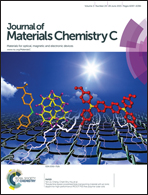Lithium ion assisted hydration of metal ions in non-aqueous sol–gel inks for high performance metal oxide thin-film transistors†
Abstract
The role of Li ions in lowering the dehydroxylation temperature of non-aqueous sol–gel inks for metal oxide thin film transistors (TFTs) was demonstrated for the first time. As a key mechanism in the lowering of the dehydroxylation temperature, the hydration of sol–gel inks by Li ions, which have a high charge density, was verified through various material analysis tools, such as Raman spectroscopy, TG-DTA, spectroscopic ellipsometry, XPS, and FT-IR. The hydration effect of Li ions on electronic properties was confirmed. This was done by evaluating the electrical properties of metal oxide TFTs that were fabricated at 300 °C using various kinds of sol–gel inks with and without Li ions. The results revealed that the dehydroxylation temperature was typically lowered by about 20 to 50 °C with the addition of Li ions to various kinds of non-aqueous sol–gel inks. Moreover, the Li-added metal oxide TFTs had mobilities that were several times higher than those of their undoped counterparts.


 Please wait while we load your content...
Please wait while we load your content...